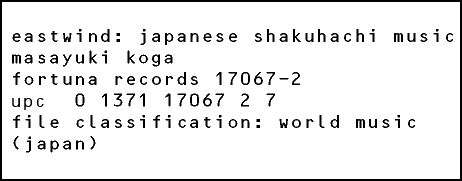 |
||||||||||||||||||||||||||||||||||||||||||||||||||||
 
Lange war die Insel wie abgeschnitten vom Rest der Welt, ihre Kultur ein Rätsel. Selbst heute erscheint diese auf dem neuesten Stand des technischen Fortschritts agierende Wirtschaftsmacht in Vielem seltsam antiquiert. Manch eine Verhandlung mit Firmenbossen scheiterte an der Missachtung von Ritualen, die ins frühe Mittelalter zurückreichen. Wer geschäftlich mit Japan zu tun hat, sollte sich in die hier vorgestellte Musik einhören. Wer meditiert oder gar Zen praktiziert, wird manches kennen, kann jedoch auch einige Überraschungen erleben. Er ist Lehrer in den beiden Hauptrichtungen der Shakuchi-Schulen oder Stilen: Kinko (der ältesten) und Tozan (der neuesten, integriert westliche Einflüsse). Koga erforschte die Flöte in vielen Aspekten, vor allem in Bezug auf die Atemtechnik. Gerade die unmittelbare Verbindung zwischen Atem und Klang machte die Shakuhachi zu dem Musikinstrument des Zen. Feinste Tonhöhenveränderungen, explosives Überblasen, ersterbender Windhauch. Dicht und expressiv wie die Zenpoesie der Haikus. the projectShakuhachi master, Masayuki Koga, is a fascinating Renaissance man: a master musician, composer, producer and engineer, trained in law, with a penchant for philosophy. His music reflects those many aspects of his personality and his skills.Born in Japan at the height of World War II, Koga followed his father's footsteps in learning to play the shakuhachi, the Japanese bamboo flute that is associated with Zen Buddhism. Although secular music has been performed on the shakuhachi for a hundred years now, it still retains its distinctly Zen aesthetic. It is capable of very subtle tonal variations and expressive nuances, all of which Koga explores with his full spirit, emotion and intellect. Koga's unique contribution has been to expand shakuhachi music, playing not only the traditional music of Japan, but blending it with Western influences. His musical training was traditional, receiving his master-teacher degree from the Tozan school. Subsequently, Koga became the youngest member of the award-winning Ensemble Nipponia. In his mid-twenties, Koga withdrew from the orchestra to broaden his musical horizons, experimenting with jazz and free form styles. Koga moved to the United States in 1972, continuing to perform widely. To further spread the understanding of his tradition in the West, Koga founded the Japanese Music Institute of America. Eastwind: Japanese Shakuhachi Music is undoubtedly an impressive production. The packaging includes a stunning rice paper booklet. The selections are carefully chosen titles from three of Koga's previous releases, Beyond Time and Space, The Distant Cry of Deer and Moon at Dawn, a perfect compilation for the audiophile interested in shakuhachi music. Masayuki Koga is a profoundly talented artist, devoted to his instrument. "The quality of your life is reflected in the quality of your sound. I can sometimes fool myself, but I can never fool the sound. I am the shakuhachi and the shakuhachi is me." discographytracklist
|
||||||||||||||||||||||||||||||||||||||||||||||||||||
|
|
||||||||||||||||||||||||||||||||||||||||||||||||||||
 |


